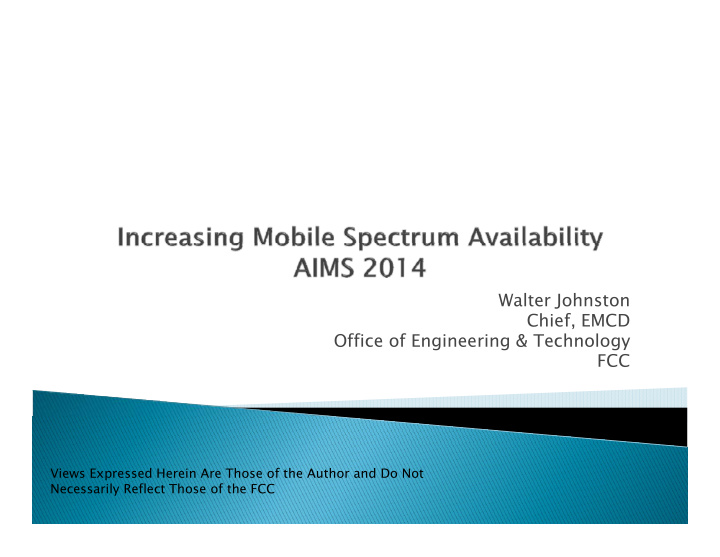



Walter Johnston Chief, EMCD f Office of Engineering & Technology FCC Views Expressed Herein Are Those of the Author and Do Not Necessarily Reflect Those of the FCC
Useable spectrum already allocated ◦ Mobile Communications: from about 600 MHz to 5 GHz ◦ Mobile Communications: from about 600 MHz to 5 GHz today Options: ◦ Reallocate spectrum to higher value usage Cost: recent estimate of $18B to reallocate 1755-1850 MHz Time: typically 10 years or more ◦ Share spectrum However incumbents protected from interference and this However incumbents protected from interference and this imposes constraints Worst case analysis often used for protection ◦ Use spectrum in higher bands Current technologies not capable within demands of size and Current technologies not capable within demands of size and power constraints
Near term ◦ Reallocate spectrum where possible R ll h ibl H Block , AWS-3, Incentive Auction 600 MHz ◦ Promote spectrum sharing opportunities while protecting incumbents ◦ Advance concept of small cell deployment with lower power levels* ◦ Examine applicability of Interference levels on future spectrum allocations* Longer term: Longer term: ◦ Work with industry on usability of Higher Band Spectrum *Recommendations of FCC Technological Advisory Council
Basic Concept: ◦ Identify unused spectrum – White Space ◦ Device/Network adapts to use it – Dynamic Spectrum Access (DSA) y p ◦ Technical standards protect incumbent services First Implementation: Provided for unlicensed p operation in white space in TV bands based on database access ◦ The result of 10 years of discussion with The result of 10 years of discussion with stakeholders
Power limit: 100 mW except 40 mW on adjacent channels 40 mW on adjacent channels May operate on channels 21-51, except channel 37 Mode I device obtains channels M d I d i bt i h l from a fixed or Mode II device Mode II device obtains channels Mode 1: Portable device obtains from database (may contact from database (may contact location/channels from fixed device database thru fixed device or Mode II device) Mode II devices re-check database daily database daily Mode I devices must contact, or receive a contact signal from, their fixed or Mode II device at Mode 2: Portable device uses its l least once per minute t i t own geolocation/database access capability
Key innovation ◦ White space channel allocation under control of database administrator Multiple database administrators Multiple database administrators Database administrators are required to work together and share registration information g g Database administrators met separately to agree on algorithms for calculating TV contours and develop a standard for information sharing
FCC/NTIA reexamined 3.5 GHz based on small cell deployment cell deployment Small cells ◦ Limited power ◦ Many in-building applications ◦ Low antenna heights Proposed Spectrum Access System p p y ◦ Protect incumbent systems ◦ Building on white spaces experience ◦ Dimensionality of spectrum access system under y p y discussion but expected to be evolved beyond white spaces Many incumbents are mobile
Incumbent protected from interference No clear definition for ‘acceptable interference’ ◦ Worst case often argued W t ft d Current rules limit transmitted power but have no impact on receiver ability to reject have no impact on receiver ability to reject interference ◦ Limited incentive for improving receiving performance
Multi-stakeholder Groups define harm claim thresholds for specific frequency bands Harm claim thresholds provide a safe harbor by defining allowable interference levels by defining allowable interference levels Shifting from Worst Case situations and no interference to a probabilistic definition of interference to a probabilistic definition of allowable interference levels Under consideration for use in 3.5 GHz
Increasing research interest in higher bands for communication purpose (> 20 GHz) communication purpose (> 20 GHz) Work coalescing under 5G Banner Advantages ◦ Large amounts of spectrum Large amounts of spectrum ◦ Small antenna size permits complex antenna arrays allowing beam forming ◦ High attenuation can be mitigated by beam forming over short distances short distances ◦ Good candidate for small cell strategies ◦ Addresses needs of future Internet of Things Disadvantages Disadvantages ◦ Device issues especially for mobile devices ◦ Many research dimensions to address: 2020+ target dates
Walter.johnston@fcc.gov Walter.johnston@fcc.gov
Recommend
More recommend